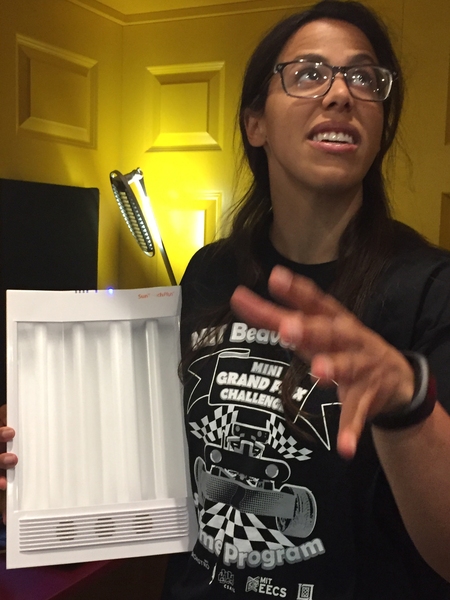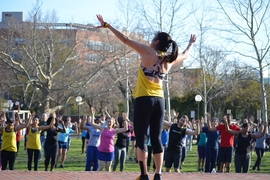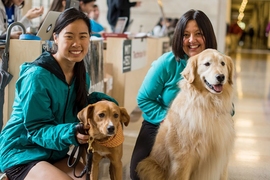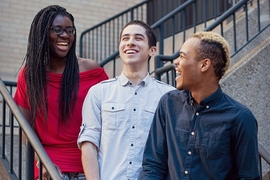It may be sweltering for most of July and August, with long lingering days, but when winter comes, with its shortness of sunlight, MIT will be ready.
In fall 2015, Ariel Anders, a fourth-year PhD student in the Department of Electrical Engineering and Computer Science (EECS), applied for and received a MindHandHeart Innovation Fund grant to install light-therapy lamps in accessible areas at MIT as a way to combat seasonal affective disorder (SAD), a type of depression that occurs at a certain time each year, usually in the fall or winter.
“During light therapy,” says Anders, “you sit or work near a light therapy box that gives off bright light that mimics natural outdoor light.” According to Anders’s project website, bright light stimulates cells in the retina that connect to the hypothalamus, a part of the brain that helps control circadian rhythms. Studies have suggested that the therapy may help with depression, sleep disorders, and other conditions.
Booths with bright-light therapy lamps are now located in the Ray and Maria Stata Center (Building 32) on floors 2, 4, and 7. The three bright red booths with sun-yellow interiors were built earlier this year as part of a Computer Science and Artificial Intelligence Laboratory (CSAIL) initiative led by John Costanza, CSAIL’s assistant director of infrastructure, who saw the need for single-user conference rooms. In each booth, safety guidelines are posted, including contact info for campus counseling resources, such as Mental Health and Counseling (MH&C) and MyLife Services. Users can switch on and off the bright light, choosing whether or not and for how long they want exposure. Anders will collect commentary in suggestion boxes and at her website, in order to help evaluate whether to expand the pilot to other areas of campus.
Typical of MindHandHeart Innovation Fund projects, Anders’s work brought together resources in different departments. In addition to Costanza, Anders worked with Robert Edwards and Peter Bochnak from MIT Environmental Health and Safety (EHS). And David V. Diamond, an occupational and environmental medicine specialist at MIT Medical, helped write the safety sheet.
Anders came up with the project “Removing SAD from Winter” when she experienced her own symptoms and recovery. Born and raised in California, Anders was “pretty scared of winter” when she moved to Boston to attend MIT. “During my second winter here,” she says, “I worked, ate, and went to the gym at Stata. I started getting pain in my wrists and went to a doctor, who suggested a blood test to determine if I had a vitamin D deficiency.” When tests showed she did, Ariel started taking vitamin D supplements and purchased a light box. “I stopped biking, to get a longer walk in the sun during the morning and used the lightbox consistently at my office desk. Within a couple of weeks my mood was lifting and my wrists were better too! When the Innovation Fund came out, it seemed straightforward to try to get some [light boxes] installed in places on campus for other people to use.”
Anders sees multiple benefits to her pilot project and hopes to expand installations to multiple campus locations. In addition to therapy, she says, the project “educates and informs people about SAD, which Massachusetts residents are particularly susceptible to during the winter.”
The MindHandHeart Initiative will again open for Innovation Fund grants this fall. Selection is made in partnership with the UA Committee on Student Support and Wellness and the GSC Committee on Housing and Community Affairs. During September, keep an eye out for implementation of current Innovation Fund projects such as Jared Berezin’s interactive glass sculpture, “Helping You, Helping Others”; Natalie Nichols’s “Indoor Student Gardens”; and the return of “MIT Puppy Lab.” Meanwhile, summer 2016 saw the launch of Rheinila Fernandes’s “Motivate and Move” series for cooking, dance-movement, and healthy mindset in a graduate dorm, as well as Suzanne Barry’s “Notice and Respond” trainings for responding to students in distress.










